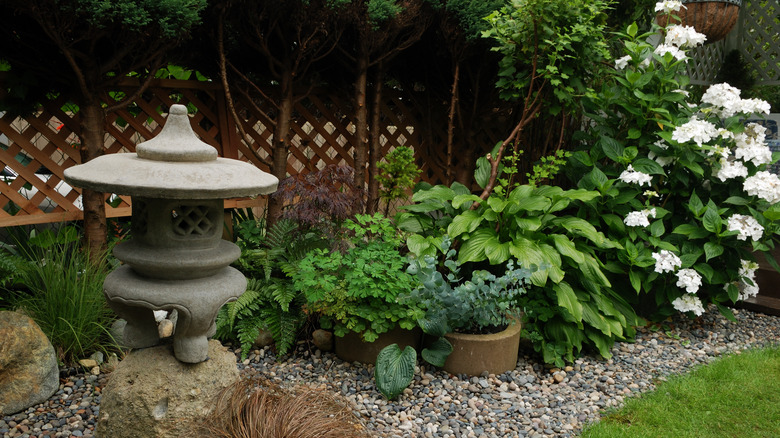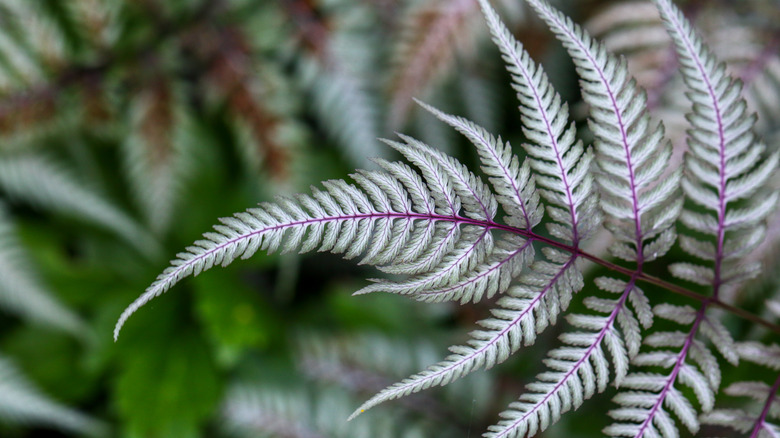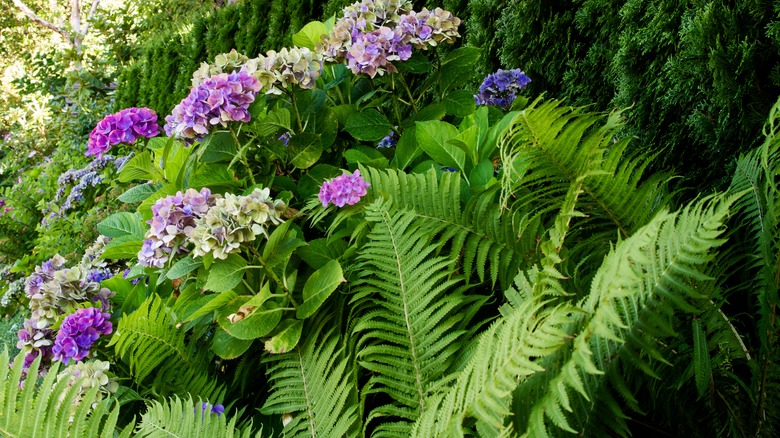Why Japanese Painted Ferns Are The Companion Plant Hydrangeas Deserve
Hydrangeas are shade garden stars with their colorful blooms lighting up dark garden corners. Finding the perfect companion to plant with your hydrangeas can initially seem challenging since not every plant can thrive in the conditions hydrangeas love. Luckily the gorgeous Japanese painted fern doesn't just look beautiful next to hydrangeas, but it also flourishes in a similar habitat.
Not only do Japanese painted ferns (Athyrium niponicum var. pictum) and hydrangeas both love shade, but they also thrive in many of the same zones. Japanese painted ferns are hardy in zones four through nine, the same range most types of hydrangeas grow well in. There are multiple species of hydrangeas, including the classic bigleaf hydrangea (Hydrangea macrophylla) which boasts pH-sensitive flowers that change color depending on soil acidity but cannot flower well in zones colder than six. The beautiful panicle hydrangea (Hydrangea paniculata), whose flowers evolve from green to cream to pink throughout the summer, can thrive in regions as cold as zone three and as warm as zone eight. Another popular species of hydrangea is the oakleaf hydrangea (Hydrangea quercifolia), which is native to the southeastern United States and is hardy in zones five through nine.
Caring for ferns and hydrangeas
Hydrangeas and Japanese painted ferns have more in common than just their shade preference and growing zones. Both types of plants grow best in well-draining soil with plenty of organic matter. They also both benefit from moist but not soggy soil. Bigleaf hydrangeas are especially prone to drooping if they don't receive enough water.
Japanese painted ferns perform best in relatively acidic soil, with a pH between 4.5 and 6.5, while hydrangeas generally prefer a soil pH between 5 and 7. Aiming for a slightly acidic pH can keep both plants happy and result in beautiful blue flowers on most bigleaf hydrangeas. Measuring the pH of your soil will help to ensure both your ferns and your hydrangeas grow their best. If necessary, lime can be added to the soil to increase the pH, and sulfur can be used to lower it.
Using Japanese ferns and hydrangeas in the garden
Both hydrangeas and ferns are known for their love of shade, but it's a bit more complicated than that. Japanese painted ferns can grow in anything from dappled sun to deep shade, while most hydrangeas grow best in part shade. Panicle hydrangeas can generally handle more sun than their bigleaf relatives, making them a good option for areas where sun exposure changes throughout the year.
While Japanese painted ferns grow to only one or two feet tall and wide, hydrangeas come in a much wider variety of sizes, ranging from the petite Bobo hydrangea that stays about four feet tall, to the massive Limelight hydrangea that can grow to over 10 feet. These larger shrubs make a perfect backdrop for the unique leaves of the Japanese painted fern. Mix in additional plants, including astilbe and other flowers that grow perfectly in shade. The addition of hellebores, hostas, and spring-flowering bulbs will provide multiple seasons of interest, all with relatively little sunlight.


